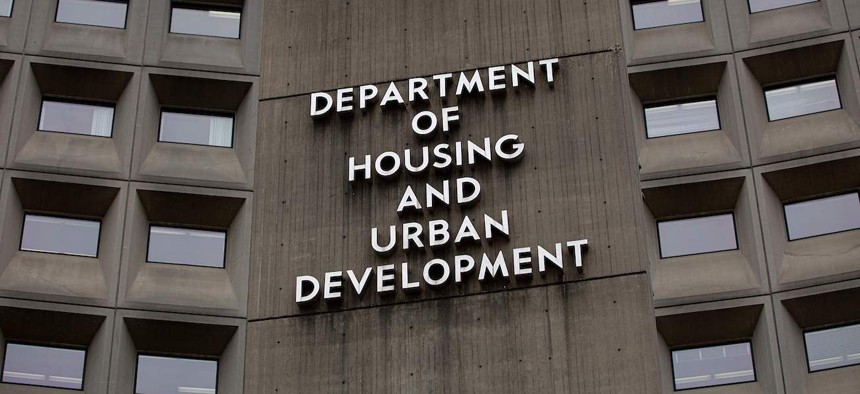
The Department of Housing and Urban Development building is seen in Washington, D.C, on July 22, 2019. According to the Government Accountability Office, HUD was among a few agencies who averaged about 9% utilization of their headquarters’ office space over three nonconsecutive weeks in January, February and March 2023. ALASTAIR PIKE/AFP via Getty Images
Some federal agencies utilize 25% or less of their headquarters office space, GAO says
As federal employees continued use of telework remains contentious, the watchdog highlighted in a new report that age-old office space problems have become more pronounced.
Three years removed from the dramatic pandemic-influenced escalation of telework and coming a breath before a potential budget shutdown, the Government Accountability Office said Wednesday that some of the largest federal agencies utilize only a portion of their office space.
In a report examining the effect of increased telework and legacy federal property management challenges, the watchdog said during a three-week review, on average, 17 federal agencies only utilized an average 25 percent or less of their headquarters office space.
The report looked at 24 federal agencies that make up the Federal Real Property Council — an interagency group of senior officials representing agencies holding 98 percent of all federal real property — over three nonconsecutive weeks in January, February and March 2023.
In measuring the utilization of the agencies’ headquarters office space, GAO divided the agencies into four categories, or quartiles, that determined their building’s use by calculating its usable square feet by how many people were there during the day.
According to the report, the departments of Commerce, Homeland Security, Justice, State and Treasury, alongside the Nuclear Regulatory Commission, were in the highest-utilized quartile, occupying on average 36% of their office space, but with an expansive range of results.
On the other end of the spectrum, the departments of Agriculture and Housing and Urban Development, along with the General Services Administration, Office of Personnel Management, Small Business Administration and Social Security Administration averaged about 9% utilization of their headquarters’ office space.
Two other quartiles — which included massive agencies like the departments of Transportation and Veterans Affairs and the departments of Defense and Health and Human Services, averaged 16% and 23%, respectively.
The calculations aren’t without controversy. The report noted that some agencies disagreed with how GAO recorded office capacity or areas deemed as usable space.
“For example, the National Aeronautics and Space Administration stated that our calculation included common areas, conference rooms and other spaces, thus overstating its capacity. We found that agencies use different methodologies to measure space utilization in federal buildings,” the report said, noting that GAO used benchmarks from the Office of Management and Budget and GSA to help determine how to classify the office space.
The watchdog also concluded that increased telework, building configurations not aligned to modern workplace requirements and longstanding issues with filling offices that predated the pandemic were at the heart of the office space issues.
GAO officials went on to note that they calculated if all assigned staff were to occupy one of the headquarters in the lowest quartile for one day, “it would still only use 67 percent of the building’s capacity based on its usable square feet.”
The report also said that the in-office workforce at the 24 agencies still has not returned to pre-pandemic levels, though agencies' use of telework and remote work varies based on need.
“Agency officials ranked the need for additional budget resources to reconfigure their spaces to support a hybrid office environment—one with a mix of in-office and remote staff—as the top challenge to increasing utilization of their headquarters building,” the report said. “Specifically, they said they would need to transform traditional office configurations into hybrid offices, allowing for more efficient use and better support of office sharing.”
Agencies also pointed to a lack of consistent benchmarks to determine proper office utilization in a high-telework climate.
“Furthermore, we found that agencies use a mix of badge swipes, network logins, self-reporting or guard tracking to measure attendance at their headquarters and generally did not track attendance in the field,” the report said. “These differences feed into additional differences in how agencies measure building capacity.”
Nevertheless, GAO noted that the 24 FRPC agencies spend $2 billion a year to operate and maintain federal-owned office buildings and about $5 billion annually to lease offices that could be reduced with better utilization.
Federal telework has come under fire recently. Republicans on Capitol Hill are attacking the practice — with Sen. Joni Ernst, R-Iowa, leveling accusations of “fraud” at federal workers — while the White House continues to push for a reduction in telework in favor of return-to-office policies.







